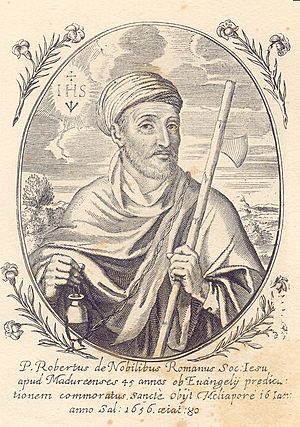Roberto de Nobili facts for kids
Roberto de Nobili (1577 – 16 January 1656) was an Italian Jesuit missionary. He traveled to Southern India to share Christianity. He used a special way of teaching called adaptation. This meant he adopted many local Indian customs. He believed these customs did not go against Christian beliefs.
Roberto's Time in India
Roberto de Nobili was born in Montepulciano, Tuscany, in September 1577. He arrived in Goa, India, on May 20, 1605.
After a short stay in Cochin, Kerala, he moved to Madurai in Tamil Nadu in November 1606. He started calling himself a "teacher of wisdom" (தத்துவ போதகர்). He also began to dress like a Sannyasi, which is a Hindu holy person.
Roberto de Nobili was from a noble family. He used this background to connect with high-caste people. He often talked with Hindu scholars about Christian ideas.
Learning Languages and Customs
De Nobili learned Sanskrit, Telugu, and Tamil languages very well. His teacher was Shivadharma. Max Muller, a famous scholar, called him "the First European Sanskrit scholar."
As he taught Christian ideas in Tamil, he created new words. He used "kovil" (கோவில்) for a place of worship. He used "arul" (அருள்) and "prasadam" (பிரசாதம்) for grace. He also used "guru" (குரு) for a priest or teacher. He called the Bible "Vedam" (வேதம்) and Mass "poosai" (பூசை).
He also adopted many Indian customs. He shaved his head but kept a small tuft of hair. He wore a white dhoti (a traditional cloth) and wooden sandals. This made him look like a sanyasin. He also wore a three-stringed thread across his chest. He explained this thread as a symbol of the Holy Trinity: Father, Son, and Holy Spirit.
Roberto de Nobili was one of the first Europeans to truly understand Sanskrit and Tamil. He wrote many books in Tamil. These included lessons, defenses of his beliefs, and philosophical discussions. He helped a lot in developing modern Tamil writing.
Roberto de Nobili died in Mylapore, near Chennai, Tamil Nadu, on January 16, 1656. He was 79 years old.
Roberto's Legacy
Roberto de Nobili left a lasting impact.
- In 2013, Loyola University Chicago opened a residence hall named de Nobili Hall. This building houses about 200 first-year students. It also has a large dining hall.
- A Telugu historical novel called Ekaveera features a character based on Roberto de Nobili. The book shows him teaching Christianity while dressed as a Hindu sanyasi.
- In Jharkhand, India, there are eight schools named De Nobili School. These schools are run by Jesuits and are connected to the CISCE education board in New Delhi.
See also
 In Spanish: Roberto de Nobili para niños
In Spanish: Roberto de Nobili para niños
- Jesuits
- Matteo Ricci
- Malabar rites
- Roman Catholic Brahmin
- John de Britto, a later Jesuit missionary who followed de Nobili's method and was martyred in south India


